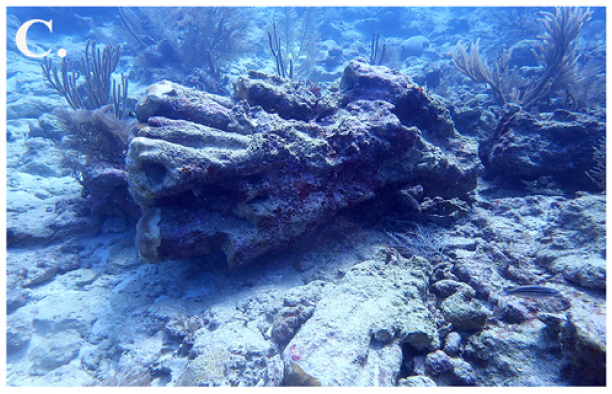Preliminary assessment of the impact of Hurricane Iota on coral reefs in Providencia and Santa Catalina Islands
Evaluación preliminar del impacto del huracán Iota en arrecifes coralinos de las islas de Providencia y Santa Catalina
DOI:
https://doi.org/10.25268/bimc.invemar.2022.51.1.1164Keywords:
Tropical-cyclone, Colombian-Caribbean, Orbicella annularis, fragmentation, bioerosionAbstract
Hurricanes are important natural destructive forces for coral reefs that can change the structural component of the habitat. On November 16th, 2020, the hurricane Iota passed ~10 km north of the islands of Providencia and Santa Catalina with sustained winds of a category 5 hurricane. The purpose of this study was to document the magnitude of the impact on coral reefs around
the islands two weeks after the hit, as part of the “Operación Cangrejo Negro”. Visual assessments were performed at 11 representative coral reef formations between 2 and 17 m depth. Estimates of the impact were evaluated within an approximate area of 200 m2, which was categorized with score values ranging from 0 to 5 according to the level of damage. Preliminary estimates at coral reef formations indicated impact in 72 % of the stations surveyed, concentrated mainly on shallow areas (5-7 m). Approximately 45 % of the sites had low to low-medium damage and 27 % showed medium to moderate damage with high variability between and within stations. From this preliminary assessment we conclude that the impact was widespread along the island on shallow areas structured by big boulders of Orbicella spp., mainly related to colony-level damage with less reef structural damage.
References
Beeden, R., J. Maynard, M. Puotinen, P. Marshall, J. Dryden, J. Goldberg and G. Williams. 2015. Impacts and recovery from severe tropical cyclone Yasi on the Great Barrier Reef. PLoS ONE, 10(4): e0121272. https://doi.org/10.1371/journal.pone.0121272
Bythell, J.C., E.H. Gladfelter and M. Bythell. 1993. Chronic and catastrophic natural mortality of three common Caribbean reef corals. Coral Reefs, 12: 143-152.
DIMAR. 2020. Huracán Iota categoría 5. Comunicado Especial No. 5, lunes 16 de noviembre de 2020-9:00 am. Dirección General Marítima-CIOH
Done, T.J. 1992. Effects of tropical cyclones waves on ecological and geomorphological structures on the Great Barrier Reef. Cont. Shelf Res., 12: 859-872
Edmunds, P.J. and J.D. Witman. 1991. Effect of Hurricane Hugo on the primary framework of a reef along the south shore of St. John, US Virgin Islands. Mar. Ecol. Prog. Ser., 78: 201-204
Emanuel, K. 2005. Increasing destructiveness of tropical cyclones over the past 30 years. Nature, 436: 686–688. https://doi.org/10.1038/nature03906
Gardner, T.A., I.M. Cōte, J.A. Gill, A. Grant and A.R. Watkinson. 2005. Hurricanes and Caribbean coral reefs: impacts, recovery patterns, and role in long term decline. Ecology, 86(1): 174-184
Gil-Agudelo, D.L., R. Navas-Camacho, A. Rodríguez-Ramírez, M.C. Reyes-Nivia, S. Bejarano, J. Garzón-Ferreira yG.W. Smith. 2009. Enfermedades coralinas y su investigación en los arrecifes colombianos. Bol. Invest. Mar. Cost. 38 (2). 189-224
Harmelin-Vivien, M. 1994. The effects of storms and cyclones on coral reefs: a review. J. Coast. Res., 12: 211-231
Knowlton, N., J.C. Lang and B.D. Keller. 1990. Case study of natural population collapse: post-hurricane predation on Jamaican staghorn corals. Smithson. Contr. Mar. Sci.,31:1-22
Knutson, T.R., J.K. Mcbride, J. Chan, K. Emanuel, G. Holland, C. Landsea, I. Held, J.P. Kossin, A.K. Srivastava and M. Sugi. 2010. Tropical cyclones and climate change. Nat. Geosci., 3: 157-163. https://doi.org/10.1038/ngeo779
Mann, M.E. and K.E. Emanuel. 2006. Atlantic hurricane trends linked to climate change. EOS, 87(24): 233-244. https://doi.org/10.1029/2006EO240001
Manzello, D., M. Brandt, T.B. Smith, D. Lirman, J.C. Hendee and R.S. Nemeth. 2007. Hurricanes benefit bleached corals. PNAS, 104(29): 12035–12039. https://doi.org/10.1073/pnas.0701194104
Navas-Camacho, R., D. L. Gil-Agudelo, A. Rodríguez-Ramírez, M. C. Reyes-Nivia and J. Garzón-Ferreira. 2010. Coral diseases and bleaching on Colombian Caribbean coral reefs. Rev.Biol. Trop., 58: 95-106.
Ortíz, J.C. 2007. Huracanes y tormentas tropicales en el mar Caribe colombiano desde 1900. Bol. Cient. CIOH, 25: 54-60
Rodríguez-Ramírez, A. yM.C. Reyes-Nivia. 2008. Evaluación rápida de los efectos del huracán Beta en la isla de Providencia (Caribe colombiano). Bol. Invest. Mar. Cost., 37(1): 215-222
Rogers C.S., L.N. McLain and C.R. Tobias. 1991. Effects of hurricane Hugo (1989) on coral reef in St. John, USVI. Mar. Ecol. Prog. Ser., 78: 189-199. https://doi.org/10.3354/meps078189
Sánchez L., J.D. González, N. Bolaños yR. Azcárate. 2020. Evaluación preliminar del estado de los arrecifes de coral y pastos marinos de la isla de providencia tras el paso del huracán Iota. Informe Técnico Coralina–Invemar. Invemar, Santa Marta. 32 p.
Saunders, M.A. and A.R. Harris. 1997. Statistical evidence links exceptional 1995 Atlantic hurricane season to record sea warming. Geophys. Res. Lett., 24: 1255-1258
Taylor, E., D. Hernández, F. Howard, G. Peñaloza, S. Posada, N. Howard, R. Robinson yM. Prada. 2007. Impactos en los arrecifes de coral ocasionados por el huracán Beta en la plataforma insular de Old Providence y Santa Catalina. Bol. Cient. CIOH, 25: 71-77
Wahle, J.L. Wulff, A.S.G. Curtis, M.D. Dallmeyer, B.P. Jupp, M.A.R. Koehl, J. Neigel and E.M. Sides. 1981. Hurricane Allen’s impact on Jamaican coral reefs. Science, 214(4522): 749-755.
Webster, P.J., G.J. Holland, J.A. Curry and H.R. Chang. 2005. Changes in tropical cyclone number, duration, and intensity in a warming environment. Science, 309(5742): 1844-1846.
Woodley, J.D., E.A. Chornesky, P.A. Clifford, J.B.C. Jackson, L.S. Kaufman, N. Knowlton, J.C. Lang, M.P. Pearson, J.W. Porter, M.C. Rooney, K.W. Rylaarsdam, V.J. Tunnicliffe, C.M. Wahle, J.L. Wulff, A.S.G. Curtis, M.D. Dallmeyer, B.P. Jupp, M.A.R. Koehl, J. Neigel, and E.M. Sides. 1981. Hurricane Allen’s impact on Jamaican coral reefs. Science, 214(4522): 749-755.
Zea, S., J. Geister, J. Garzón-Ferreira and J.M. Díaz. 1998. Biotic changes in the reef complex of San Andres Island (Southeastern Caribbean Sea, Colombia) occurring over three decades. Atoll Res. Bull., 456: 1-30

Downloads
Published
How to Cite
Issue
Section
License
Copyright (c) 2021 Carlos Gómez, Santiago Millán, Andrés Acosta-Chaparro, Alfredo Abril-Howard, Raúl Navas-Camacho

This work is licensed under a Creative Commons Attribution-NonCommercial-ShareAlike 4.0 International License.

